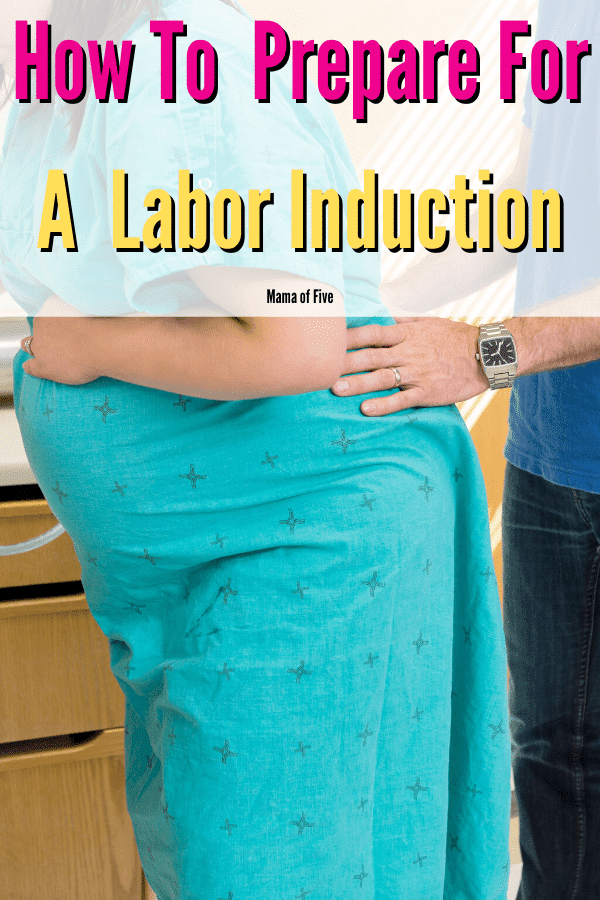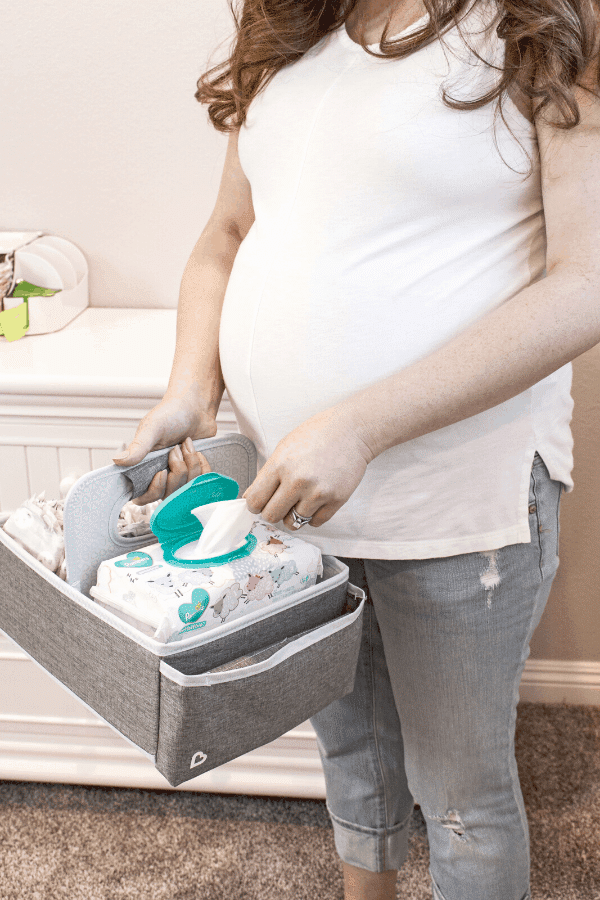After nine months of waiting, you are now just days away from the big day.
As you prepare for the coming weeks and months, you are probably planning for the day you give birth.
Of course, we typically plan for a natural delivery with little medical intervention.
However, there are times when medical intervention is necessary for labor, so you may find yourself wondering how you can prepare for labor induction.
How do you prepare for labor induction? Sometimes a labor induction is necessary for the birthing process, and you will want to prepare yourself for this by bringing some essentials in your hospital bag, mentally preparing yourself, and arranging for the planned induction.

As an Amazon Associate I earn from qualifying purchases. The links below may be affiliate links. Please read my disclosure policy for more information.
Typically, you will know in advance if you will be induced.
This advantage allows you to plan for the birth when usually it’s a spur of the moment event.
Having time to prepare, there are some things that you can do to help plan for labor induction.
There are some things from home that you will want to bring, but there are also other ways to prepare too.
How To Prepare For A Labor Induction
Labor induction is when there is medical intervention to “jumpstart” labor in hopes of your body delivering the baby.
These are necessary in specific situations such as a case of gestational diabetes, low or high blood pressure, or passing your due date.
When a doctor orders a labor induction, there are a few things that will happen. These are:
1. You will be hooked up to medical equipment in the hospital and assigned a room.
2. The doctor will induce labor by using some of these methods.
3. Inserting a gel capsule in your vagina to cause your cervix to prepare for birth.
4. Breaking your water
5. Receiving an IV of Pitocin, which is a medication that causes your uterus to contract.
6. You will be monitored throughout labor and delivery.
7. Some inductions are not successful, so you may experience a cesarean delivery if labor does not go as planned.

RELATED: THE BEST ONLINE BIRTHING CLASSES COMPARED
Will my labor Induction be more painful than a Natural Birth?
The most significant difference between planned labor induction and labor-inducing naturally is often the level of pain.
The medications given to you to jumpstart your labor will cause your body to go into labor almost immediately after they are administered.
In a more natural process, labor begins slowly, and the body gradually prepares over time. In an induction, the process starts rapidly with little room to adjust.
You may find yourself wanting pain medication during the induction, and that is nothing to be ashamed of.
Labor inductions are notoriously more painful than a natural delivery, so many women opt to use pain medication as a result, when they hadn’t planned to do so.
The best way to prepare for labor induction is to do your research and prepare mentally.
Labor inductions can be just as lengthy, if not longer, than natural labor so you will be spending a while in the hospital.
If you know about your induction in advance, you can even prepare for induction by bringing along some extra essentials.
YOU MAY ALSO LIKE: THE TRUTH ABOUT PAIN RELIEF IN LABOR

What To Bring For A Labor Induction
For the most part, you will bring along the same essentials as if your delivery was starting naturally. Some of these recommended items are:
• Nursing pads: The hospital generally does not provide these.
• High waisted underwear: The hospital will have disposable underwear, but it’s more comfortable to wear your own. Be sure to buy a pack of comfortable high waisted underwear.
• Baby book: The nurses will help you record the birth information, and they may even offer to get the baby’s first footprint.
• Maxi pads: The hospital will provide these, but they are often big and bulky. You will be more comfortable in your preferred brand of maxi pads.
• Nursing bra: Your breasts will likely be tender and engorged, so bring a soft cotton nursing bra.
• Money for the vending machine: You may want some snacks during your stay, so bring some change.
• Baby blankets: The hospital will probably be drafty, so it’s a good idea to bring along some baby blankets to keep your new baby warm.
• Burp cloths: These are essential from the beginning and will save you from having spit up on your shoulders.
• There are a few things that you may want to also bring along to prepare for labor induction. These things are:
• Picture or object to mentally focus on while coping with the pain
• Music to listen to during your labor
• Slippers to wear while pacing the halls of the hospital
• Change of clothes for you and your significant other as the process may be a long one

YOU MAY ALSO LIKE: MY HONEST REVIEW OF BIRTH IT UP ONLINE CLASS
How To Emotionally Prepare For A Labor Induction
Labor induction is similar to a natural delivery in many ways, but there are some differences.
One of the most significant differences in the level of pain and the intensity of labor because labor induction techniques are known to “slam” you into labor with little time to cope and adjust to the process.
Labor induction can be emotionally exhausting and very difficult to deal with.
There are ways that you can do to emotionally prepare for labor induction.
Preparing yourself mentally for a labor Induction
When preparing for your labor induction, you can also prepare yourself mentally.
One way to do this is to work on your breathing exercises. It would be best if you recognized that while it will be painful, it won’t last forever; there will be an end.
At the moment, it may feel like there is no escape but you should find comfort in the fact that the pain will be temporary.
You may have to change your expectations if induction is imminent
When considering your impending labor induction, you may have to revisit the expectations of your labor and delivery.
You may have things you want to include in your birth plan, but the medical necessity of the induction comes first so that you may have a change of plans.
For example, you might want to avoid pain medication, but many use pain medication in a labor induction due to the extraordinary pain and it should probably be considered in the event of extreme pain.
I wish I had taken the epidural when I was Induced with my third child. The pressure that I felt to have a natural labor overtook what would have been much easier labor if I had listened to my body.
YOU MAY ALSO LIKE: HOW TO RECOVER AFTER A VAGINAL DELIVERY

How To Prepare To Manage Pain In A Labor Induction
Now that you are going to have a labor induction, it’s probably a good idea to revisit your pain plan.
Many women deliver with no pain medication, and it is often a personal goal for many.
However, when labor has been induced, the pain can be much worse, so some will use pain medication when they hadn’t planned to do so otherwise.
There are several ways that labor and delivery pain are medicated. Some of these ways are:
• Epidural: This is the most common form of pain medication used during labor and delivery. This is when a small tube is inserted near your spine, and pain medication is continuously administered. You will not be able to walk during labor.
• Spinal block: This type of pain medication is usually reserved for c-sections. When you are given this medication through your spinal cord, it takes away all feeling below your waist.
• Opioids: These medications are used to lessen the pain. It doesn’t make the pain go away completely and it often causes drowsiness or nausea. This is an excellent option if you want to lessen the pain but still experience the feeling of labor and delivery.
• When preparing for labor and delivery, you can explore meditation or other mind and breathing exercises.
• Many women find that the pain is more manageable when they have a coping process and they feel in control of the situation.
There are often labor and delivery classes held at local hospitals or birth centers.

How To Prepare For A Caesarean After A Failed Labor Induction
While the hospital may have a planned labor and delivery process for you, things may not go as planned.
Despite all the medical interventions, there are times when an induction fails, and the only option is to deliver the baby via Caesarean section.
While the idea of a cesarean may seem very distant, it should be recognized as a possibility if the induction fails.
When preparing for your planned labor induction, you should also plan for a possible cesarean.
You should revisit your birth plan and discuss it with your doctor.
There are some things that you can request during a cesarean to make the experience more enjoyable for you and the baby. Some ideas are:
• Skin to skin: You can request skin to skin contact after birth if you have a cesarean.
• Lower the curtain: Some doctors will lower the curtain a little to allow you to watch the birth. This can make it feel more natural.
• Breastfeeding: Some doctors will assist you in breastfeeding your baby after birth.
• Music: Some doctors will allow you to play music during the operation.
• Narration: Ask the doctor to explain the operation as they go along so you know what’s going on.
• Leave one arm free: When you are being prepared for your operation, the doctor will strap your arms to a board by your sides. You can request for one of your arms to remain free so you can hold your baby when they are born.
• Baby tests: You can ask that the initial screenings of your baby when they are first born to be done while they lay on your chest as opposed to the baby carrier across the room.






